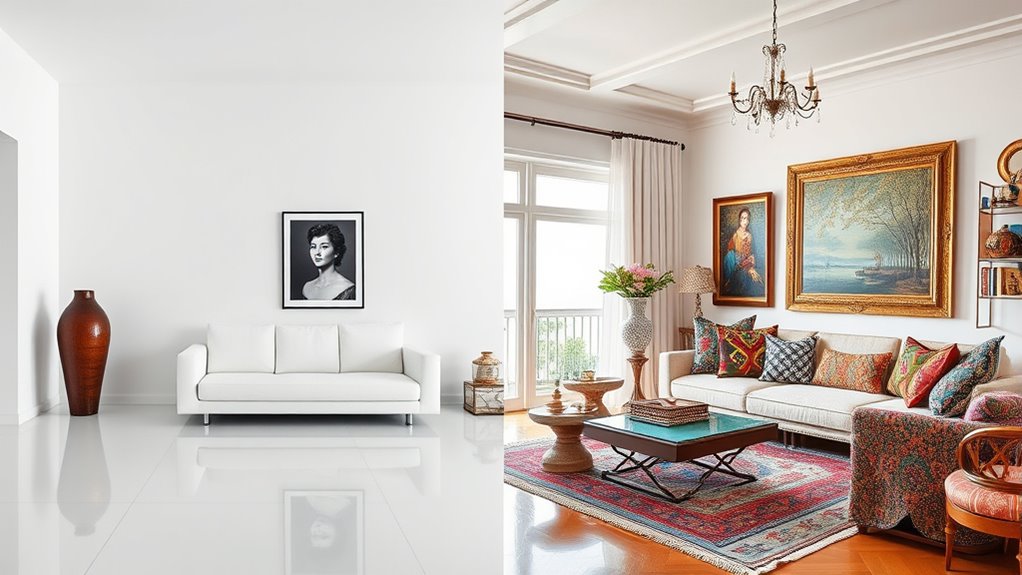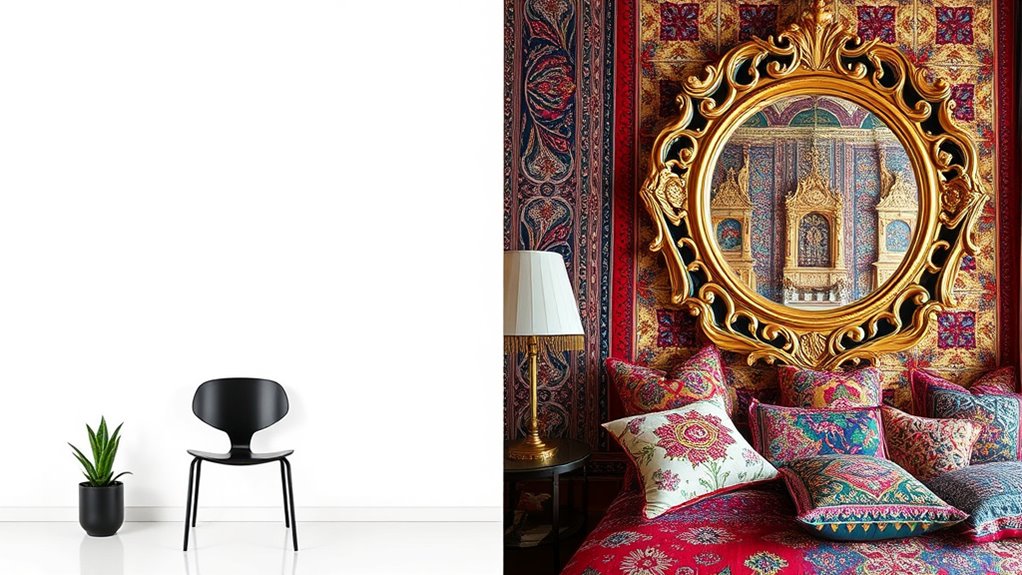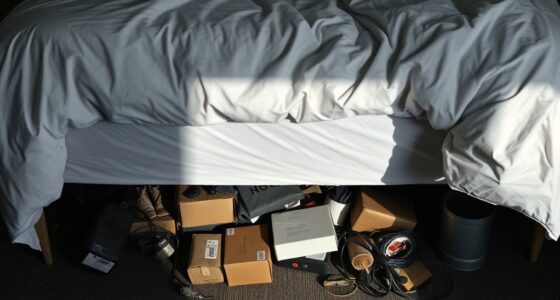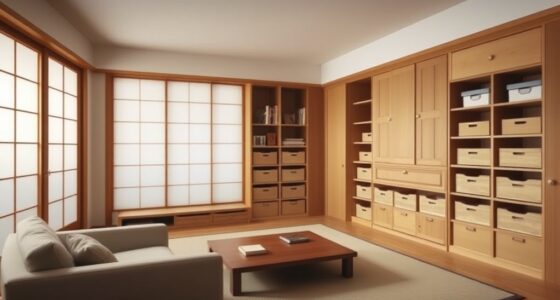Choosing between minimalism and maximalism depends on your personality and how you want your space to feel. If you prefer calm, clean lines, and less clutter, organize with simple storage solutions that highlight quality pieces. If you love vibrant colors, layered textures, and personal collections, embrace creative display methods that showcase your personality. Whichever style resonates most, organizing your space thoughtfully can help it reflect your true self, and there’s more to explore if you keep going.
Key Takeaways
- Determine if you prefer calm and simplicity or vibrant and expressive environments to guide your organization style.
- Use minimal storage solutions for minimalist spaces, focusing on decluttering and purposeful placement.
- Incorporate layered storage and display options to manage and showcase collections in maximalist designs.
- Balance open spaces with meaningful objects to maintain harmony between minimalism and maximalism.
- Customize organization techniques to reflect your personal style, blending elements for a unique, functional space.

Have you ever wondered why some spaces feel calming and simple, while others seem vibrant and crowded? The answer often lies in how you choose to organize and style your environment. When you lean toward minimalism, you prioritize simplicity, stripping away excess to focus on only what truly matters. It’s about creating a sense of calm by reducing clutter, using clean lines, and embracing open space. You might find that with fewer items, your mind feels less overwhelmed, and your surroundings become easier to maintain. Minimalism encourages you to select quality over quantity, making every piece in your space purposeful. This approach can help you feel more relaxed and centered, especially when your environment isn’t competing for your attention. Additionally, understanding interior design principles can help you craft spaces that enhance your well-being and reflect your personal style.
On the flip side, maximalism celebrates abundance, color, and personality. It involves layering textures, mixing patterns, and filling your space with meaningful objects. This style invites you to express your unique tastes and tell stories through your decor. When you adopt maximalism, you intentionally surround yourself with things that inspire joy and curiosity. It’s about creating a vibrant, dynamic environment that feels alive and personal. You might love collecting artworks, vintage finds, or decorative items that showcase your interests and experiences. Maximalism can energize your space, making it feel warm and inviting, but it also requires careful organization to prevent chaos. When done right, it’s a reflection of your personality, full of character and life.
Choosing between minimalism and maximalism isn’t about right or wrong; it’s about what suits you best. If you crave tranquility and clarity, minimalism might be your style, helping you focus and breathe easier. But if you thrive on diversity and expressive decor, maximalism offers a canvas for your creativity. You can even blend elements of both, creating a personalized space that’s balanced and functional. The key is to organize according to your preferences—keeping clutter at bay, whether that means minimal storage solutions or clever ways to display your collections. You’re the one designing your environment, so consider what makes you feel most at home. With intentional organization, you can craft a space that aligns perfectly with your style, offering comfort, inspiration, and a reflection of who you are.
Frequently Asked Questions
How Do I Determine My Personal Organizing Style?
You determine your personal organizing style by paying attention to how you feel in your space. Do you prefer clean, simple lines and less clutter, or do you enjoy vibrant, layered decorations? Experiment with different arrangements, notice what makes you feel most relaxed or inspired, and adapt over time. Trust your instincts and choose methods that genuinely resonate with your personality and lifestyle.
Can I Combine Minimalism and Maximalism?
Yes, you can definitely combine minimalism and maximalism. Start by identifying which areas benefit from simplicity and which thrive on bold, layered decor. Use minimalism in spaces where you want calm and focus, and add maximalist elements where you seek personality and vibrancy. Balance is key—mixing clean lines with eclectic accessories creates a unique, personalized look that reflects your evolving style.
What Are Common Mistakes in Choosing a Style?
You often make the mistake of trying to do too much at once, which can create clutter and confusion. According to a survey, 65% of people feel overwhelmed by their spaces. To avoid this, focus on what truly matters to you, and don’t be afraid to let go of items or styles that don’t serve your personal aesthetic. Keep your space aligned with your preferences for a cohesive, comfortable environment.
How Does Lifestyle Influence My Organizing Approach?
Your lifestyle shapes your organizing approach because it determines what you need to keep accessible and what can be stored away. If you’re constantly busy, prioritize functional, quick-access storage. If you enjoy collecting or decorating, embrace a more maximalist style that showcases your personality. Adapt your organization to fit your routines, habits, and space, ensuring it supports your daily life rather than complicates it.
Are There Specific Colors Suited for Each Style?
Colors are the palette you paint your space with. For minimalism, stick to neutral tones like whites, grays, and beiges—think of a blank canvas waiting for your touch. Maximalism, on the other hand, embraces bold hues—rich jewel tones, vibrant patterns—that reflect your lively spirit. Choose colors that resonate with your energy, creating a space that feels like an extension of you, whether calm or colorful.
Conclusion
Ultimately, whether you lean towards minimalism or maximalism, it’s all about creating a space that gently whispers your personality. Embrace what feels right, and let your style subtly reflect your essence. With a thoughtful touch, your environment can become a calming retreat or an expressive gallery—whichever suits you best. Trust your instincts, and remember, it’s the quiet harmony behind your choices that truly makes your space uniquely yours.









